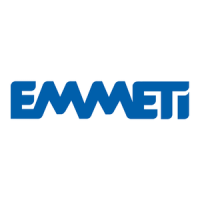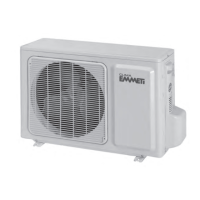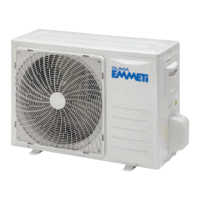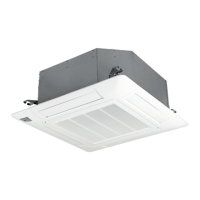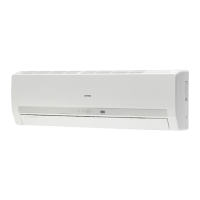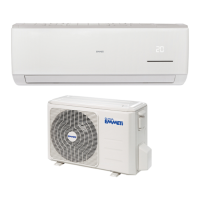
Do you have a question about the emmeti XEVO-0917 R32 and is the answer not in the manual?
| Brand | emmeti |
|---|---|
| Model | XEVO-0917 R32 |
| Category | Air Conditioner |
| Language | English |
Explains air conditioning purpose and the four stages of the refrigeration cycle.
Describes the split system (indoor/outdoor units) and remote control functionality.
Identifies parts of the indoor unit including filters, panel, deflector, and display.
Details the information shown on the indoor unit's display for various operating modes.
Lists all accessories provided with the internal unit, such as remote control and batteries.
Identifies the components of the external unit, including air grilles and connection ports.
Provides a table for identifying product models, capacities, and part numbers.
Explains warning symbols and general safety rules for operating the air conditioner.
Lists applicable EU directives for electromagnetic compatibility, low voltage, and ecodesign.
Clarifies the meaning of IP enclosure protection codes for indoor and outdoor units.
Details information about refrigerant R32, its GWP, and safe filling procedures.
Covers first aid, fire safety, and accidental release procedures for R32 refrigerant.
Provides guidance on proper handling and storage of the air conditioning unit.
Lists control parameters and exposure limits (DNEL, PNEC) for refrigerant components.
Details the physical state, boiling point, and chemical characteristics of the refrigerant.
Summarizes toxicity information and environmental impact data for the product.
Provides guidance on waste treatment methods and disposal of refrigerant and containers.
Illustrates how to handle internal and external unit packages using pre-cut handles.
Instructions for careful unpacking and verifying the unit's condition after delivery.
Offers advice on selecting optimal locations for the indoor unit, avoiding obstructions and ensuring airflow.
Provides guidance on positioning the outdoor unit to optimize performance and minimize environmental impact.
Specifies required minimum distances around the indoor unit for proper operation.
Details minimum functional distances (W, H, D) for internal units based on model capacity.
Shows dimensions and hole layouts for the internal unit mounting plate for specific models.
Outlines requirements for qualified installers and general safety precautions during installation.
Guides on fixing the installation template and positioning the wall hole for refrigerant pipes.
Details how to securely attach the indoor unit to the installation template.
Instructions for opening the front panel of the indoor unit to access internal parts.
Provides instructions for connecting refrigerant pipes, including support and routing.
Explains how to connect the drain pipe for condensate, ensuring proper drainage and insulation.
Covers electrical connection standards, safety switches, and earthing requirements.
Lists essential electrical checks before connecting the unit, ensuring compatibility and sufficiency.
Specifies power supply routing and recommends dedicated circuits for the air conditioner.
Details required cable types, sections, and approvals for power and communication lines.
Illustrates the steps for connecting electrical cables to the unit's terminal board.
Guides on routing, securing, and protecting pipes and cables externally.
Shows the wiring diagram for connecting single indoor and outdoor units, including ferrite cores.
Illustrates the electrical connections for a dual-unit system with multiple indoor units.
Depicts the electrical wiring for multi-unit (TRIAL) systems, connecting multiple indoor units.
Introduces the remote control and explains the function of each button for operating the unit.
Explains the meaning of icons and symbols displayed on the remote control interface.
Provides step-by-step instructions for inserting batteries into the remote control.
Details how to install the remote control on a wall using its support bracket.
Guides on how to initiate operation using the remote control and important considerations.
Explains how to use the FAN mode and adjust fan speeds for air circulation.
Details how to activate cooling, set temperature, and adjust fan speed.
Describes the anti-frost protection mechanism that operates during cooling cycles.
Guides on activating heating, setting temperature, and adjusting fan speed.
Explains how to use the DRY mode for reducing humidity, noting operational limits.
Details the AUTO mode where the unit automatically selects operating parameters based on ambient conditions.
Explains vertical and horizontal air flow adjustments using remote control features.
Guides on setting a timer for the air conditioner to turn on automatically.
Explains how to set a timer for the air conditioner to turn off automatically.
Describes the SLEEP mode for optimized night-time operation and its effects.
Explains the TURBO mode for rapid temperature adjustment and its availability.
Details the SILENCE mode for quiet operation and its potential impact on comfort.
Describes the SILENCE FP function for maintaining a minimum temperature in unoccupied rooms.
Explains the SELF CLEAN function to dry the indoor unit and prevent odors.
Describes the FOLLOW ME feature that uses the remote's sensor to regulate room temperature.
Explains how to turn the unit's display and indicator lights on or off.
Details the AUTORESTART feature that resumes operation after a power interruption.
Explains how to operate the unit manually without the remote control.
Describes the indicator for filter cleaning and how to reset it.
Provides advice on maximizing heating efficiency and managing room temperatures.
Offers general advice for optimal usage, including temperature setting and timer use.
Guides on cleaning the remote control using appropriate materials.
Provides detailed steps for cleaning the indoor unit, emphasizing safe cleaning agents.
Outlines the process for cleaning the outdoor unit and its grilles to maintain performance.
Step-by-step instructions for removing, cleaning, and reinstalling the internal unit's air filters.
Explains how to verify the proper functioning of the condensate drain system.
Steps to follow before storing the air conditioner for extended periods.
Procedures for resuming operation after the unit has been inactive for a long time.
Mentions professional sanitizing and periodic system checks.
Advises performing basic checks before contacting customer service for troubleshooting.
Lists common operational issues and their potential causes for diagnosis.
Explains various anomaly codes displayed on the indoor unit and their corresponding issues.
Highlights environmental protection, Kyoto Protocol compliance, and WEEE directive for disposal.
Provides instructions for the proper disposal of old air conditioners, including refrigerant.
Guides on responsibly disposing of air conditioner packaging materials.
Explains the proper disposal procedures for batteries, including recycling information.
Presents the detailed electrical schematic for the internal unit, showing component connections.
The portion of the guarantee certificate for the user to retain for their records.
The portion of the guarantee certificate for the distributor to complete and keep.
The portion of the guarantee certificate to be sent to Emmeti Spa for warranty validation.
